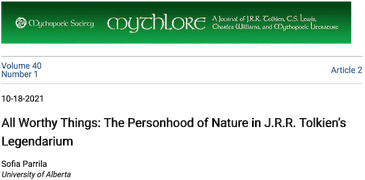
All worthy things: The personhood of nature in J.R.R. Tolkien’s legendarium
18 October 2021 | Mythlore, Volume 40, № 1, 5
This paper argues that J.R.R. Tolkien’s portrayal of plants, animals, and geographical features as morally complex persons is central to the ecocentric model of environmental stewardship developed within Tolkien’s legendarium. Tolkien’s Middle-earth writings endow non-human beings such as animals, plants, and even rivers with personhood by emphasizing their individuality, their capacity for interpersonal relationships, and their agency to make moral choices. I build on work done by critics such as Matthew Dickerson, and Jonathan Evans (Ents, Elves, and Eriador) to find a practicable and inspirational environmental ethic in Tolkien’s The Lord of the Rings, The Silmarillion, and Unfinished Tales. The most common philosophical framework for analyzing Tolkien’s environmentalism is a Catholic model of stewardship. But a traditional stewardship ethic, in which environmental responsibility belongs to human beings acting as God’s stewards, risks falling into anthropocentrism or a sense of entitlement over a nature that is understood as resources existing for human extraction. By analyzing three of Tolkien’s works — The Lord of the Rings, The Silmarillion, and the unfinished tale “Aldarion and Erendis” — this paper argues that Tolkien was aware of the limits of human environmental stewardship. Tolkien’s Catholic Christian background and his deep love for natural features interact to create an ecological ethic indebted to the stewardship model, but in which humanity does not have a monopoly on stewardship, and in which the value of non-human Creation comes directly from its personhood.
❧